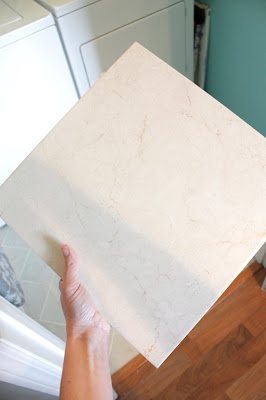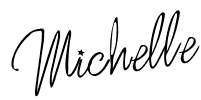Hi everyone! I'm finally done putting together a step-by-step on how Justin and I accomplished the herringbone tile in our my new laundry room. Yes, we took on a tile project!! Even though the room is TINY it really took both of us working as a team to get it done, I really could not have done it with out him! For the record, we are not professional tilers, but because the laundry room is so small, I thought it would be a good room to get our feet wet on DIY tiling. We are just a couple of people that want to save some dough and do it our self. Of course, I just couldn't be normal and lay the tile in a simple straightforward pattern, no, I had to want an intricate pattern like herringbone. Probably not the best pattern for beginners, but that's what I wanted and so we gave it a try.

Here is what you'll need for this project:
Tile*Tile cutter *Tile adhesive and grout*Notched floor trowel*Rubber grout float*Putty knife*Plastic spacers (these come in all sizes, we used the 1/8")*Sponge*Bucket*Grout Sealer

*NOTE*
Just so we are clear, because the room is so small (5X5), I chose to use a combination adhesive and grout, but if your space is large, it would certainly be more economical if you bought the unmixed grout and adhesive and then mix it yourself.

Just so you can remember where the floor began...linoleum with a couple spots of damage, original to the house.
 I removed the baseboards and ripped the flooring out and scrapped up all the adhesive spots that remained. Cleaned, swept, and vacuumed the floor.
I removed the baseboards and ripped the flooring out and scrapped up all the adhesive spots that remained. Cleaned, swept, and vacuumed the floor.
 Because we installed on subfloor (raw wood), I painted it with a primer and sealer combo. This is so there would be no chance of the subfloor absorbing the moisture from the tile adhesive and swelling, thus avoiding possible cracks in the future.
Because we installed on subfloor (raw wood), I painted it with a primer and sealer combo. This is so there would be no chance of the subfloor absorbing the moisture from the tile adhesive and swelling, thus avoiding possible cracks in the future.
 I bought the ceramic tile at Lowe's from Interceramic. The color/pattern is called Marfil Chiaro which is a marble look alike. I chose this tile because it is smooth, and has the look of marble, not rough stone like some of the ceramic tile out there. They come in a box of 15 and are 13X13 square.
I bought the ceramic tile at Lowe's from Interceramic. The color/pattern is called Marfil Chiaro which is a marble look alike. I chose this tile because it is smooth, and has the look of marble, not rough stone like some of the ceramic tile out there. They come in a box of 15 and are 13X13 square.
 I used the tile cutter to cut enough tiles in half to complete the whole floor. Justin handled the outside cuts and cuts around the vents. I totally wimped out on those!
I used the tile cutter to cut enough tiles in half to complete the whole floor. Justin handled the outside cuts and cuts around the vents. I totally wimped out on those!
 We started from the back of the room which is a little different. If you were laying tile straight, the center of the room is where to start, keeping the cuts on the outside, but in this case, everything is cut. It was easier to keep straight starting from the back and working to the front.
We started from the back of the room which is a little different. If you were laying tile straight, the center of the room is where to start, keeping the cuts on the outside, but in this case, everything is cut. It was easier to keep straight starting from the back and working to the front.
 After we had gotten a good dry fit, everything was cut right, fit well and looked good.....I went back and put the adhesive on one by one.
After we had gotten a good dry fit, everything was cut right, fit well and looked good.....I went back and put the adhesive on one by one.I know, not the traditional way, with this intricate of a pattern, it is how it worked out. There was no way in hades, after making all those pieces fit like a puzzle, was I going to take them all up to lay the adhesive down....It had to be done this way. One painstaking tile after another. You see why it took me so long!
Begin by getting some adhesive/grout on the back of the tile with a putty knife:
 'Butter' the back of the tile until it is completely covered:
'Butter' the back of the tile until it is completely covered: With the notched trowel, scrape it across the back of the tile:
With the notched trowel, scrape it across the back of the tile:
 Lay the tile back into place, give it a little shimmy, and insert spacers. Basically it's the traditional way but in reverse. I can't tell you how badly my fingers and hands hurt from doing it!!
Lay the tile back into place, give it a little shimmy, and insert spacers. Basically it's the traditional way but in reverse. I can't tell you how badly my fingers and hands hurt from doing it!!
Once the adhesive is dry (recommended 24 hours), remove the spacers
*NOTE* Thankfully, the spacers come two sided...one side is if the tile were laid straight (the 'X' side) and then the other side was straight for this sort of pattern
 Next, it's time to grout. This went a lot easier than I thought. I worked a small section at a time, putting a glob of grout down and using the rubber float to work it in between the tiles. Once I had a section done, I used the wet sponge to wipe the tiles down and get up the excess grout. When the entire floor is complete, and after another 24 hour dry time, apply another coat of grout. Because of so much shrinkage with drying, it looks better with another layer. Oh, and another 24 hours.....:) Once the second coat of grout is dry, apply the grout sealer (according to the directions).
Next, it's time to grout. This went a lot easier than I thought. I worked a small section at a time, putting a glob of grout down and using the rubber float to work it in between the tiles. Once I had a section done, I used the wet sponge to wipe the tiles down and get up the excess grout. When the entire floor is complete, and after another 24 hour dry time, apply another coat of grout. Because of so much shrinkage with drying, it looks better with another layer. Oh, and another 24 hours.....:) Once the second coat of grout is dry, apply the grout sealer (according to the directions).
It's time to reinstall the baseboards....
 ....and move the appliances back in!
....and move the appliances back in!
 We are beyond thrilled with how it turned out, as you can imagine.
We are beyond thrilled with how it turned out, as you can imagine.
 Wanna know what the sad part is????
Wanna know what the sad part is????
 That half of it is under the washer and dryer!! :)
That half of it is under the washer and dryer!! :)
 At any rate, we are glad we took on the tile!By the way, there is a 'haze that forms over the tile, after grouting...and you can purchase Haze Remover, but I found with a warm water and a little elbow grease, it came right off.
At any rate, we are glad we took on the tile!By the way, there is a 'haze that forms over the tile, after grouting...and you can purchase Haze Remover, but I found with a warm water and a little elbow grease, it came right off.
If you have any questions, or if I wasn't clear on a step, feel free to ask in the comments.
*Note* Some great advice from a reader and experienced tiler in the comments, be sure to read!


Need a design boost? For advice and guidance on style, contact me!






















































